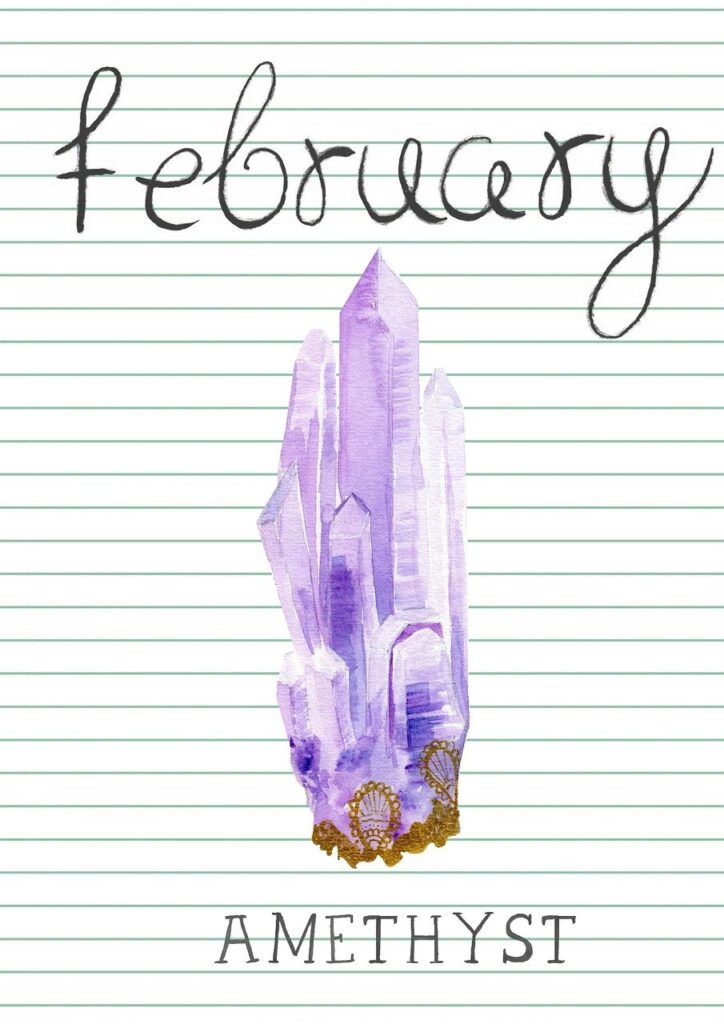Back to: The Magic of Birthstones MB1
Amethyst is crystalline quartz in colours ranging from pale lilac to deep reddish purple. It has a relatively high hardness of 7, which means it’s very scratch resistant. The February birthstone makes a fine gem for any kind of jewellery.

Symbolism
As the colour purple has long been connected with royalty, amethysts were favoured by the ruling class. Over time, amethysts have also come to be associated with spirituality, mental clarity, and healing.
Colour
Specifically a purple variety of quartz whose saturation may range from pale to vibrant. Generally speaking, vivid stones are more highly sought-after and valuable than paler ones
WHERE IS AMETHYST FOUND?
Russia was the major source of amethyst until the 19th century, when large deposits were found in Brazil. Once as rare as ruby or emerald, amethyst was suddenly in abundance. Today, the most important sources of amethyst are in Africa and South America. Brazil is still a major supplier, especially its southernmost state, Rio Grande do Sul, though the rough amethyst mined there tends to have a lighter color than amethyst found in other countries. Amethyst from Brazil sometimes forms in hollow, crystal-lined geodes so large you can stand in them.
The Anahí mine in Bolivia is another prominent source for amethyst. Hidden in the Pantanal wetlands, the Anahí mine is shrouded in fascinating lore. It was discovered by a Spanish conquistador in the 1600s, given to him as dowry when he married Anahí (a princess from the Ayoreo tribe), forgotten for three centuries, and rediscovered in the 1960s. The Anahí mine is also famous in gem circles as the source of the unusual bicolored amethyst-citrine crystals called ametrine.
In Africa, Zambia’s Kariba mine is one of the largest amethyst producers in the world. Amethyst mined there tends to be of superb quality with richly saturated colors.
Amethyst is also found in the United States, just 46 miles (74 km) outside of Phoenix, Arizona. The Four Peaks amethyst mine is located high in the most rugged part of the Mazatzal Mountains. A remote location, hot summer temperatures, and a lack of water and power at the mine make for challenging conditions. Yet this jagged, arid, rattlesnake-infested terrain produces some very fine dark purple and purplish red amethyst crystals.
AMETHYST BIRTHSTONE CARE & CLEANING
Amethyst is a 7 on the Mohs scale of hardness. This means that it is appropriate for daily use in rings and other jewelry, but over time it may show wear and require repolishing. Because this February birthstone is more susceptible to damage than harder gems such as rubies, sapphires and diamonds, you risk scratching your amethyst jewelry if you place it next to these harder stones…
Heat treatment is the most common technique for improving the color and marketability of natural amethyst. Heat treatment can’t make pale amethyst darker, but it can lighten the color of very dark amethyst and make it more attractive. It can also remove unwanted brownish inclusions in some amethysts. Some amethyst turns yellow – to citrine – with heat treatment.
Heat treating amethyst results in a permanent change in color. However, submitting it to intense heat may render it slightly more brittle than usual, and care must be taken not to damage pointed faceted corners and sharp edges. Note, too, that excessive heat can remove the color entirely, and some amethyst fades with prolonged exposure to strong light. Though the color is stable with normal use, this is not a birthstone to wear to the beach every day.
Amethyst birthstone jewelry can be cleaned with an ultrasonic cleaner, but steam cleaning is not recommended. A soft brush with mild soap is the safest option.
As you shop for the February birthstone, you’ll also encounter lab-created amethyst. Having the same chemical and physical properties as its natural counterpart, synthetic amethyst has been known since the 1970s. In some cases, it is very difficult to distinguish natural from synthetic amethyst without access to advanced gemological testing. The GIA Laboratory can tell the difference, but many in the jewelry industry do not request testing because of the cost and time required to determine the origin of what is a comparatively inexpensive gem. Still, merchants are required to tell you if a gem is natural or synthetic.